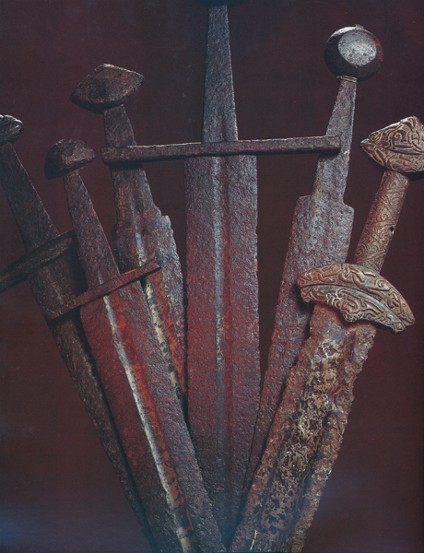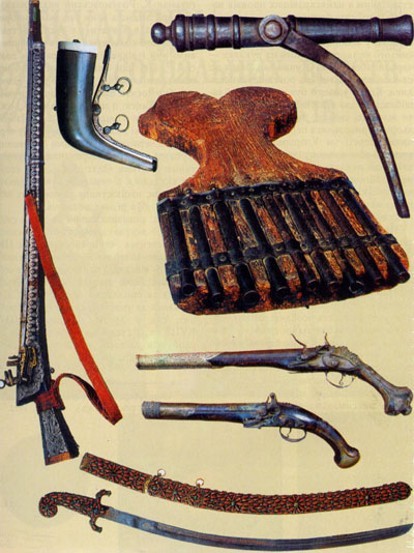Arms
Arms. Various means of assault and defense. The basic types of weapons are cutting and thrusting weapons, firearms, nuclear weapons, rockets, defensive armor, and the instruments of chemical, biological, and psychological warfare.
Cutting and thrusting weapons—the sword, saber, battle-ax—and defensive armor—helmet, cuirass, shield, etc—appeared long ago. Before gunpowder was discovered and firearms were invented in the 13th–14th century, the same purpose was served by the sling, bow and arrow, and such assault engines as the ballista, catapult, and battering ram. The bow in its improved forms was used not only as a hunting weapon, but also as a military weapon until the 18th century. Ballistic military engines were used for two millenniums and gave way to the new form of fired artillery only in the 14th century. Projectiles of different types were used for different purposes: rocks, logs, and arrows for smashing; pitch in barrels for burning; scorpions, snakes, and decaying corpses for poisoning.
The development of arms in Ukraine during the Princely era was influenced by the steppe hordes, Varangians, and Byzantines. Offensive and defensive weapons consisted of slings, spears under various names (kopiia, sulytsia, rohatyna, oskep), swords, sabers, battle-axes, bows and arrows, and maces. Defensive arms consisted of helmets (sometimes with visors), hauberks or suits of armor, and shields. War engines of the catapult and battering-ram type were used and were known as porok and vozhrada.
Beginning with the 14th century, firearms came gradually into use in Ukraine. Heavy firearms—field and fortification artillery—appeared first. Much later small firearms appeared. The bow in its advanced forms of the arbalest and kushcha (cross-bow) was used up to the 18th century in Ukraine.
The arms of the Cossacks consisted of rifles, pistols, pistolettes, bows, sabers, spears, battle-hammers (kelepy), and battle-picks (chekany). In contrast to Western European armies, the Cossack Host used no defensive arms such as the helmet or armor. Only the Cossack officers wore them, and then only for ceremonial functions. The first cannons were imported into Ukraine in 1394, and by 1580 the Cossacks were making their own at the Zaporozhian Sich. The various types of cannon were called pushka, tarasnytsia, shrubnytsia, serpentyna, petriiera, falkon, kartavna, etc.
In the Princely era and the Cossack period the more complicated and advanced arms were imported into Ukraine from Byzantium, Western Europe, Turkey, the Near East, and, after 1654, Muscovy. But local craftsmen made arms too: swords, sabers, bows, arrows, muskets, cannons, etc. The first cannon foundry was established in Lviv in 1468. Under the rule of Bohdan Khmelnytsky and Ivan Vyhovsky cannons were made in Korsun and probably in Pereiaslav. In the Hetman state the main centers of gunmaking were Hadiach, Baturyn, and Hlukhiv. Hetman Ivan Mazepa paid particular attention to developing his artillery.
During Ukraine's struggle for independence (1917–20) Ukrainian armies used mostly the arms that formerly belonged to the Russian or Austro-Hungarian armies. In mid-1919 all Ukrainian artillery regiments were armed with Russian cannons, mostly three-inch guns, which were considered to be the best in Europe at the time.
In the Second World War Ukrainian military formations such as the Division Galizien used mostly German arms, while the Ukrainian Insurgent Army used both German and Soviet arms.
BIBLIOGRAPHY
Smol's'kyi, H. ‘Zbroia ukraïntsiv vid naidavnishykh chasiv,’ Kalendar Chervonoï Kalyny na 1924 (Lviv 1923)
Kryp'iakevych, I.; Hnatevych, B. (eds). Istoriia ukraïns'koho viis'ka (Lviv 1936, 2nd edn Winnipeg 1953)
Stefaniv, Z. Korotka istoriia ukraïns'koho viis'ka, 1 (Lviv 1936)
Denisova, M.; Portnov, M.; Denisov, E. Russkoe oruzhie (Moscow 1953)
Zenon Stefaniv
[This article originally appeared in the Encyclopedia of Ukraine, vol. 1 (1984).]

.jpg)
